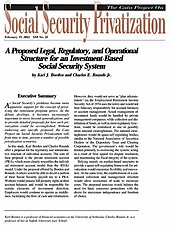In this study, Karl Borden and Charles Rounds offer a proposal for the regulatory and administrative structure of individual accounts. The core of their proposal is the private retirement account (PRA), which more closely resembles the individual retirement account model than the 401(k) model. Under the proposal offered by Borden and Rounds, workers would be able to divert a portion of their Social Security payroll tax to a PRA. Workers would possess full property rights in their account balances and would be responsible for certain elements of investment direction. Employers would continue to operate as middlemen, facilitating the flow of cash and information. However, they would not serve as “plan administrators” (as the Employment Retirement Income Security Act of 1974 uses the term) and would not bear fiduciary responsibility for account balances or account management. Actual management of investment funds would be handled by private management companies, while collection and distribution of funds, as well as most regulatory func-tions, would be centralized in one or possibly more national clearinghouses. The national clearinghouses would be quasi-self-regulating bodies, similar to the National Association of Securities Dealers or the Depository Trust and Clearing Corporation. The government’s role would be limited primarily to overseeing the system, acting as a court of final appeal for dispute resolution, and maintaining the fiscal integrity of the system.
Relying mainly on market-based structures to provide a quasi-self-regulating framework for privatization would maximize flexibility and innovation. At the same time, the establishment of a centralized collection and management structure would allow economies of scale to minimize costs. The proposed structure would balance the need for basic consumer protections with the desire for maximum independence and freedom of choice.

